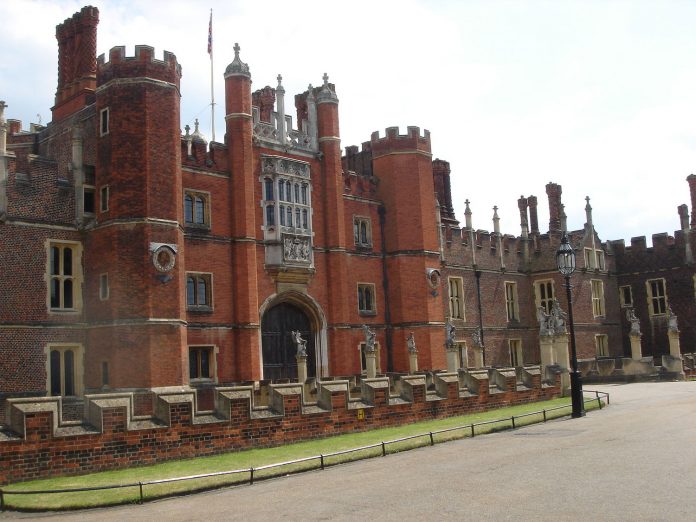[dropcap]A[/dropcap]rchaeologists working at Hampton Court Palace, the site of King Henry VIII’s famous royal residence, have unearthed the earliest surviving building ever discovered at the historic site. Predating any other finds made at the palace by nearly 200 years, these highly significant thirteenth and fourteenth century remains include the largest medieval building (other than the Great Hall itself) constructed at the site. The impressive discoveries were made during the biggest excavation project ever undertaken at Hampton Court Palace by conservation and heritage charity Historic Royal Palaces, as part of a project to represent one of Henry VIII’s Tudor courtyards for the 500th anniversary of his accession to the throne in 2009.
The unexpected discoveries were made in Base Court, the primary and largest interior courtyard of the Tudor palace, where excavations led by Oxford Archaeology have revealed the stone foundations and walls of a substantial medieval structure. Measuring 10m wide by at least 25m long, it was originally constructed around the mid 14th century, making it the earliest building ever identified at Hampton Court. It was subsequently rebuilt in the late 15th century to form part of a group along with two other buildings that have been revealed. Whilst curators suspected that medieval buildings were located in the area the extent, location and nature of these buildings remained unknown until archaeologists carefully uncovered the physical evidence that has remained quietly hidden beneath the feet of millions of visitors for almost half a millennium.
Whilst there is much speculation by archaeologists and curators about what the buildings were and how they were used, some very interesting possibilities are being considered. One theory is that the larger and earlier structure might be a simple barn, or more tantalisingly a hall or residential building that was part of the large manor of Hampton Court when the site was in the hands of Knights Hospitallers, a revered order of military monks. The residential theory concurs with a story of a visit by Edward III and his entourage to Hampton Court in 1353. During his stay a fire broke out – for which the King admitted blame – and he subsequently paid for the reconstruction work, bringing his carpenter from Windsor Chapel to oversee it. Archaeologists working on the site have unearthed evidence of a fire in this large building, possibly the very building destroyed by King Edward.
The later group of buildings were part of the estate of Giles Daubeney, Lord Chamberlain and favourite of King Henry VII and veteran of the Battle of Bosworth Field, who acquired the manor in the 1490s. Together these could represent a residential wing of his medieval house where guests, including Henry VIII’s parents Henry VII and Elizabeth of York who (according to medieval documents) visited Hampton Court, would have been entertained. Evidence from these buildings that supports this theory shows that they would have been quite lavishly decorated with all the mod-cons of the period such as a decorated tiled floor and leaded windows.
Archaeologists believe, however, that they have begun to unravel the mystery of the third and perhaps most enigmatic discovery: a medieval water feature complete with 500 year old lead plumbing still in situ. This sophisticated and quite ostentatious feature is clear evidence of the wealth and status of the residents of the manor estate who as well as Daubeney included John Wode, a favoured royal servant of Edward IV and Richard III. Hampton Court provided the ideal location between Westminster and Windsor for these courtiers to base themselves. Later the site’s convenience as well as idyllic surroundings attracted Cardinal Wolsey and then King Henry VIII to make Hampton Court their home.
These exciting archaeological finds have been carefully excavated and recorded by a team from Oxford Archaeology who will continue to analyse and study the results with curators from Historic Royal Palaces after the excavations have finished. Meanwhile the project to represent Base Court for the 500th anniversary of King Henry VIII’s accession to the throne will be complete by March 2009, heralding the beginning of a series of representations, exhibitions, events and activities to mark this historic anniversary at Henry’s most famous royal residence.


